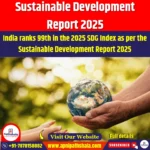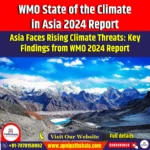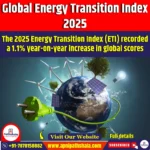Sustainable Development Report 2025
General Studies Paper III: Environmental Pollution & Degradation, Inclusive Growth |
Why in News?
Recently, the Sustainable Development Report 2025 highlighted slow global progress on key goals. The report showed that most countries are off track to meet the 2030 deadline. It called for urgent financial reforms and stronger cooperation.
Key Highlights from the Sustainable Development Report 2025
- Overall SDG Performance: The report examines how each of the 193 United Nations member nations is performing on the 17 Sustainable Development Goals.
- It confirms that no SDG is currently on track to be met by 2030.
- Only 17 percent of the 169 SDG targets have shown meaningful advancement so far.
- 17‑Indicator SDGi: This year, the report introduced a simplified SDG Index (SDGi) that highlights one key indicator per goal.
- It uses one key indicator per SDG, enabling clearer benchmarking and easier tracking. This index minimizes data gaps and aligns with recent SDG reviews.
- Regional Performance: Since 2015, countries in East and South Asia have made the most significant strides in SDG outcomes.
- South Asia recorded the fastest SDG progress worldwide since 2015.
- Nepal improved its SDG Index score by 11.1 points, while Bangladesh and the Philippines saw gains of 8.3 and 8.6 points respectively, placing them among the top global improvers.
- Nordic countries—Finland (1st), Sweden (2nd), Denmark (3rd)—continue to top the SDG Index rankings.
- Successes: Despite overall lag, some SDG areas show notable improvements. Access to electricity (SDG 7), mobile broadband (SDG 9), and child survival rates (SDG 3) have increased significantly since 2015.
- Financial Architecture: Half of the global population lives in countries that lack sufficient fiscal space.
- The report stresses reform of the Global Financial Architecture to unlock more capital flow to emerging economies. It positions the Financing for Development Conference (June–July 2025) as a pivotal moment.
- Multilateral Support: The report adds a unique UN-based multilateralism index (UN‑Mi). It gauges countries’ financial and policy support for UN systems. Barbados ranks first, while the United States ranks last in 2025.
- Sustainability: The report frames sustainable development as a high-return investment opportunity. It estimates a $12 trillion annual business potential across sectors like energy, food, health, and cities.
- Concerns: The report flags major issues affecting SDG progress: climate impacts, widening inequality, poor biodiversity protection on land and in oceans, and fragile global financial systems.
- Global inequalities are rising, and funding remains insufficient—particularly for low- and middle-income countries.
India and Its Neighbouring Country’s SDG Performance
- India achieved a major milestone in 2025 by entering the top 100 in the SDG Index ranked 99th with a score of 67 / 100.
- This marks its first-time placement in this group and a notable climb from its 109th position in 2024.
- India showed steady SDG progress, advancing from 121st rank in 2022 to a higher position by 2025.
- Bhutan secured the highest SDG Index score among India’s neighbouring countries, standing at rank 74 with 70.5 points.
- Nepal stands at 85th with 68.6, showing strong recent improvement.
- Bangladesh holds 114th position scoring 63.9.
- Pakistan appears at the bottom of the regional list with a ranking of 140 and a score of 57.
- Key Takeaways:
- All countries in the region show gains in basic services.
- Electricity and internet access have expanded rapidly across the region since 2015.
- Loss of biodiversity and rising inequality affect regional performance.
- Bangladesh, Pakistan, and Nepal face high urban pollution and health risks.
- Dhaka in Bangladesh sees rising slum settlements, stressing services.
- Nepal and India are strengthening ties by jointly investing in hydropower development for shared benefit.
- Regional climate planning and SDG coordination could improve outcomes across borders.
What Are the SDGs: Origin, Publisher, and Significance
- Introduction:
- The 17 Sustainable Development Goals are designed as global commitments to address critical challenges.
- Each goal addresses a specific area of human and environmental well‑being.
- They range from ending poverty and hunger to ensuring health, education, clean water, sustainable energy, climate action, and biodiversity protection.
- These goals offer a connected and worldwide approach to achieving balanced development.
- Adoption:
- In September 2015, all 193 member nations of the United Nations formally adopted the SDGs.
- This commitment marked a decisive shift from the earlier Millennium Development Goals to a broader and deeper approach addressing sustainability.
- The goals set a clear agenda guiding progress through 2030.
- 17 Sustainable Development Goals (SDGs):
- No Poverty
- Zero Hunger
- Good Health and Well-being
- Quality Education
- Gender Equality
- Clean Water and Sanitation
- Affordable and Clean Energy
- Decent Work and Economic Growth
- Industry, Innovation and Infrastructure
- Sustainable Cities and Communities
- Responsible Consumption and Production
- Climate Action
- Life Below Water
- Life on Land
- Peace, Justice and Strong Institutions
- Partnerships for the Goals
- Report Publisher:
- Each year, the Sustainable Development Solutions Network (SDSN) publishes the Sustainable Development Report.
- Monitoring the SDGs helps governments and communities understand where they stand.
- Since 2016, this report has tracked progress on each of the 17 goals worldwide.
- In 2025, the report introduced a simplified “SDG headline index” using one core indicator per goal to make global comparisons clearer and more actionable.
- Objectives:
- The goals aim to improve daily lives. They address poverty, hunger, well-being, and fairness.
- They also focus on safe schools, clean water, secure jobs, and decent housing.
- SDGs also act to protect our environment. Goals cover climate action, water bodies, terrestrial ecosystems, and responsible use of resources.
- They advocate for cleaner energy, sustainable cities, and reduced pollution.
- The 17 SDGs are designed to be interlinked. Progress in one area supports others to improve overall.
India’s Progress Towards Achieving the SDGs
- India shows meaningful reductions in extreme poverty. By 2023, over 52.4% of people accessed at least one social protection benefit, up from 42.8% in 2015.
- India has significantly expanded renewable energy capacity. As of Oct 2024, 46.3% of total installed electricity capacity came from renewables. Solar power alone reached over 110 GW by mid-2025.
- SDG 7 performance rose, boosted by clean cooking access under Ujjwala scheme.
- Health outcomes have improved. As of September 2024, 67 million ABHA health IDs were issued with 42 million linked medical records.
- Meanwhile, Pradhan Mantri Jan Arogya Yojana (PM-JAY) empanelled nearly 30,000 hospitals by March 2024.
- India recorded large gains in sanitation under the Swachh Bharat mission. Around 149 million households received piped drinking water via Jal Jeevan Mission.
- India’s Human Development Index reached 0.685 in 2023, moving up from 0.676 in 2022, and ranking 130th globally.
- NITI Aayog leads SDG tracking at state and district levels through the SDG India Index and the North-Eastern District Index.
- India progressed the fastest among G20 nations since 2015. India continues to invest in clean energy, health, education, and sanitation.
- In Budget 2024–25, India introduced a draft Climate Finance Taxonomy to guide funding into green projects.
- India uses institutions like the National Investment and Infrastructure Fund (NIIF) and the Green Growth Equity Fund to promote sustainable projects in sectors such as energy, transport, and water.
- As part of the Lifestyle for Environment (LiFE) mission, the Green Credit Programme launched in 2023.
- Under the National Infrastructure Pipeline, the government backed ₹1.97 lakh crore (~US $1.4 trillion) in projects through 2025.









